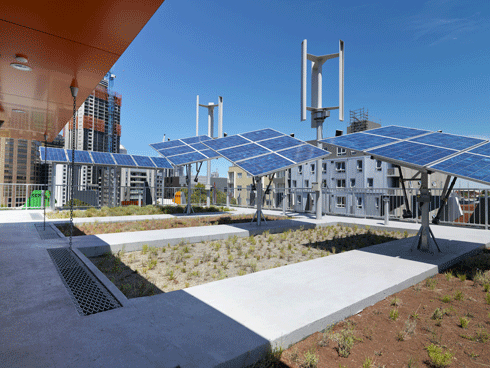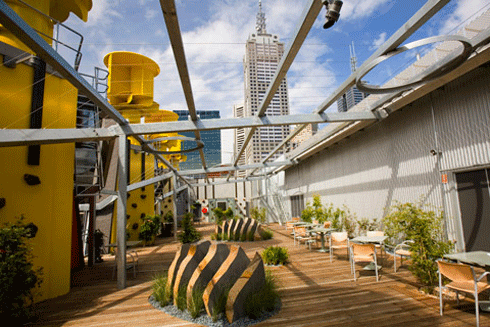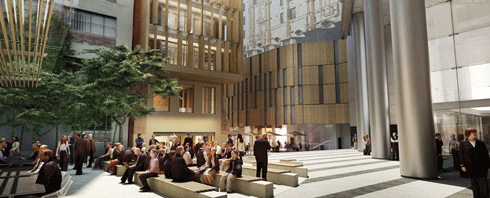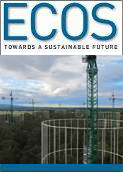
|
Published: 22 October 2012
Whichever way you look at it, green buildings save dollars and make sense
Green buildings are improving sustainability and helping to combat climate change. Australia is at the forefront of this effort, and is recognised a global leader in the green building space. There is, however, room for improvement.
Buildings have had a reputation as voracious consumers of resources that gave little back. As we have constructed our cities, factories and homes, we have also built significant environmental problems. The issues still emanating from the industry are huge – the building sector generates 40 per cent of all waste sent to landfill, while buildings consume 40 per cent of all electricity and 12 per cent of potable water.1
The construction industry also drives global demand for concrete and steel – some of the world’s most carbon-intensive products. Poor design is another problem, making many buildings dependent on extensive air-conditioning systems to keep cool.
Worse still, the design and materials used can be bad for our health. Low levels of fresh air and sunlight and volatile organic compounds emitted from paints, carpets and furniture are all symptomatic of ‘sick building syndrome’.
Luckily, since the early 2000s, green buildings have been delivering solutions to these issues and offering hope for the future. Take Melbourne, for example. First, there was 60L – an innovative green building financed by the Australian Conservation Foundation with help from the Green Building Partnership. 60L demonstrated that sustainable buildings were both possible and practical.
The next major milestone was the construction of the City of Melbourne’s world-leading CH2 building. This building was crucial in encouraging private sector investment by demonstrating the business case to support cutting-edge design.
Then in 2011 we saw the completion of the Pixel building in Carlton – a carbon-neutral building seen as the office of the future. Pixel achieved perfect scores under the leading green-building assessment tools – Green Star, LEED and BREEAM. Promisingly, Pixel was delivered by a private developer, proving the business case for green buildings across the investment spectrum: from light green to deep green designs.
Investment in green buildings makes sound financial sense. A well-designed green building doesn’t need to cost any more than a non-green building. Through smart design, Australian architects can substantially improve a building’s sustainability without it costing a cent more than its conventional counterpart.
Green buildings also save money by using less energy and water. Studies have shown that green buildings use, on average, 26 per cent less energy than conventional buildings, while also eliminating all use of potable water, except for drinking purposes.
The real economic driver is staff productivity. Studies have shown productivity gains of 10 per cent for people working in green buildings, compared to equivalent non-green buildings. The winning combination of more daylight, better air quality, and higher staff morale seems to be the key to reducing sickness and improving retention, hence driving up productivity.
This productivity incentive has led to a surge in green buildings around the country: it is now rare to find a premium-grade office building that hasn’t achieved a Green Star or NABERS (National Australian Built Environment Rating System) rating.
Unfortunately, not all sectors have followed suit. Despite the well-documented health, economic and environmental benefits, the uptake of green buildings beyond the CBD office market has been slow, mainly due to concerns about higher costs and static returns of green buildings.
The reality is very different. Australian Property Institute research has shown that rents for Green Star-rated buildings are five per cent higher than non-green buildings, with the physical green buildings being valued 12 per cent higher.
What’s more, it’s becoming increasingly possible to construct green buildings on standard budgets, meaning there is no cost barrier to realising these financial benefits. As high-performing assets that deliver greater returns than traditional buildings, green buildings are an increasingly wise investment.
Some inroads are being made beyond the commercial property space. Australia’s universities have begun to engage in a green building ‘arms race’ to attract the environmentally conscious student (for example, Monash University). These buildings aren’t just there for the feel-good factor – they also improve student outcomes. Higher reading retention levels, better concentration and reduced staff sickness mean that students in green buildings not only feel good, but learn better than their peers in conventional buildings.
Technological advances continue to reveal previously unrealised green building opportunities. According to Arup, the William McCormick Place Stage 2 building in Far North Queensland is pushing the boundaries of efficient cooling in tropical climates, with the installation of a 1.5-million-litre chilled water tank inside the building to keep it cool.
In Sydney, a waste-paper-fired cogeneration plant will provide both energy and heating for the redeveloped Legion House building. And, in Western Australia, the Australian Institute of Management’s Katitjin Centre has achieved energy neutrality – producing as much energy as it uses.
Legion House is targeting both a 6 Star Green Star Office Design and As Built ratings with the Green Building Council of Australia. The project will be targeting one of the highest scores yet to be achieved in Australia, and the highest for a refurbished heritage building.
There is, however, room for improvement in the residential, medium-sized commercial, and healthcare building sectors. We need to call on policy-makers to develop incentives and regulations that will encourage green building leaders to aim higher and lift the laggards to a green minimum.
In a world constrained by rising environmental pressures, green buildings can be the foundations of a more sustainable future – slashing carbon emissions, conserving water and improving human health.
Tom Quinn previously worked with the Green Building Council of Australia advocating policies to increase the uptake of green buildings in Australia. He is an alumnus of the Centre for Sustainability Leadership and a researcher and International Politics Tutor at LaTrobe University.
This is an edited version of an article first published in Open Forum, an independent, non-profit think-tank built around a community blog moderated by Global Access Partners (GAP).
|
Melbourne’s pioneering 60L building, headquarters of the Australian Conservation Foundation, marked the 10th anniversary of its launch on 18 October 2012. |
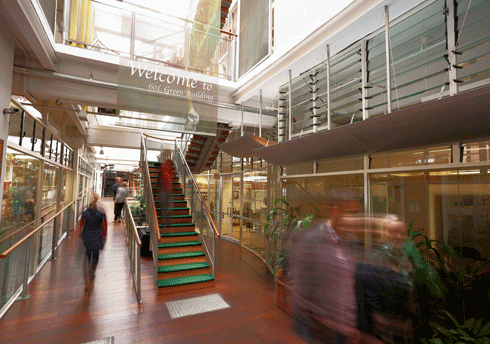
The designers of 60L aimed to maximise the efficiency of energy and natural lighting, minimise use of mechanical heating/cooling and artificial lighting systems, minimise waste and provide a healthy efficient work environment. Credit: Matthew Stanton/ACF
|
‘60L proves an office building can have a very low environmental footprint and still be a healthy, comfortable and productive place to work,’ said Andrew Gemmell, 60L’s Building Manager since 2003. |
‘It has set new standards for low energy use, natural airflow and water efficiency in offices and we continue to look for new ways to improve the building’s performance.’ |
As well as being ACF’s home, 60L’s tenants include Going Solar, Environment Victoria, BirdLife Australia, the Victorian National Parks Association, the Planning Institute of Australia, the Nature Conservancy, the Environment Defenders Office, the Victorian Local Governance Association and the electorate office of State MP Greg Barber. |
1 See for example ESD Design Guide For Office And Public Buildings (2007) Edition 3. Sustainable Built Environments and Centre for Design, RMIT University, and Department of the Environment and Water Resources. ISBN 0 642 553 491


